Trade news
According to an article from Reuters, a coffee centre near Dubai’s Jebel Ali port has been opened which offers the opportunity to store and to process coffee beans in the Middle East.
Being modern and able to handle up 20’000 tonnes of coffee beans annually in bulk or in speciality (equivalent to $100 million according to Sanjeev Dutta, executive director for commodities at DMCC), this coffee centre is equipped of temperature-controlled facility for coffee beans, and offers infrastructure and services for the processing and the delivery.
The advantage of this coffee centre is that it is the only one located in the Middle East. Thanks to this advantage, coffee traders could use this centre as a distribution hub for the region and get a bigger margin in the redistribution of their coffee beans.
The purpose of The Dubai Multi Commodities Centre (DMCC) is to attract major coffee trading house, as well as small and medium players in the coffee market, to bring and deal their business in this new coffee centre.
Indeed, in our opinion, this would increase the revenue of the center by receiving the payment of the storage costs paid by traders. Moreover, the concerned port in Dubai will have a competitive advantage compared to the other ports of the region because, traders could use this new center as a storage point and could distribute easily coffee beans in different volumes in the region.
Until now, the coffee beans in bulk that have already gone through this coffee centre were from South America and East Africa. However, the location of this centre is interesting and well-positioned for coffee traders who deal with Asian producers such as coffee producers from India or Indonesia.
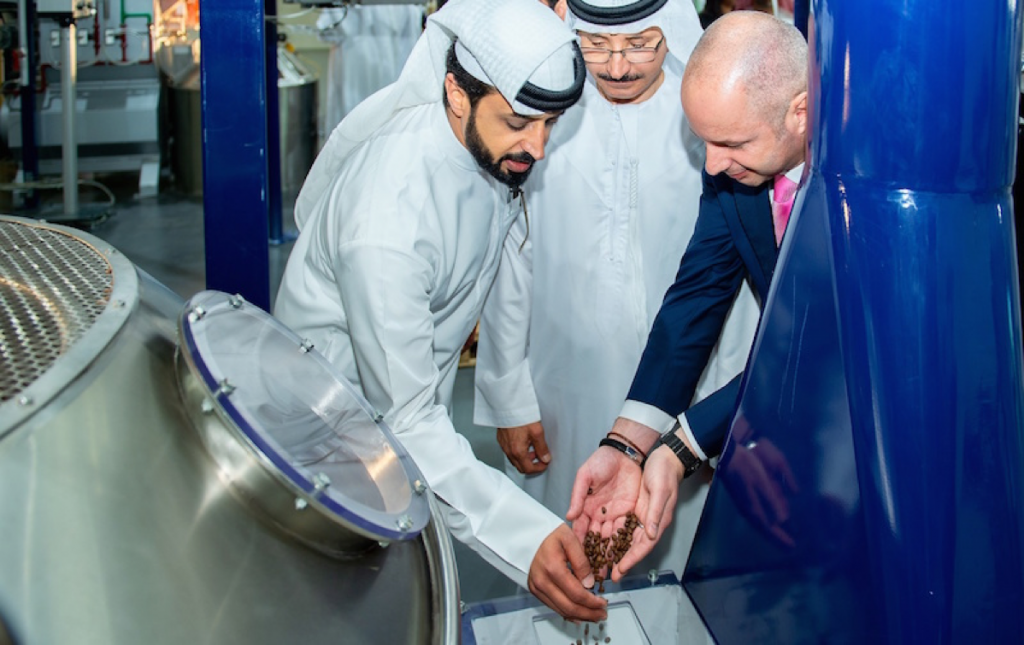
Coffee at all time low in 13 years
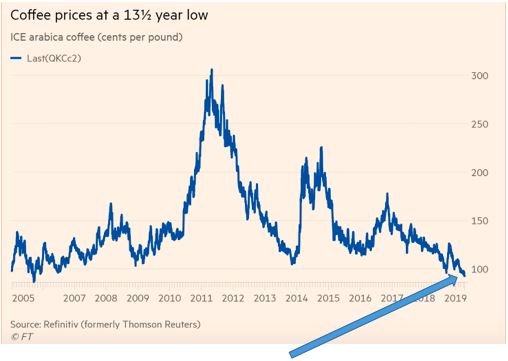
The coffee is traded at an all-time low of 93 cents a pound for the Arabica (spot prices US April 2019). The cost of production should be around $1,20 to $1,50 per pound for the many small producers to breakeven. In Guatemala, farmers are abandoning the farms while Colombians are turning into Cocoa production. The problem is that the market is largely driven by the Brazilian coffee (about ¼ of the world’s coffee trade). The oversupply from the country (62m in 2018) made the price drop low. Moreover, the Brazilian Real has depreciated, pushing them to export even more: the coffee is traded in dollars, which gives the incentives to Brazilian farmers to export and get more money from it.
What would be a coffee trader’s position right now while the price of coffee is historically falling? As we know, traders are hedging their physicals with futures. As we know too, traders are long physical and short futures. Let us remember that traders are not trying to get money from the futures, but trying cancel out the risk.
Futures comparison since beginning of the semester:
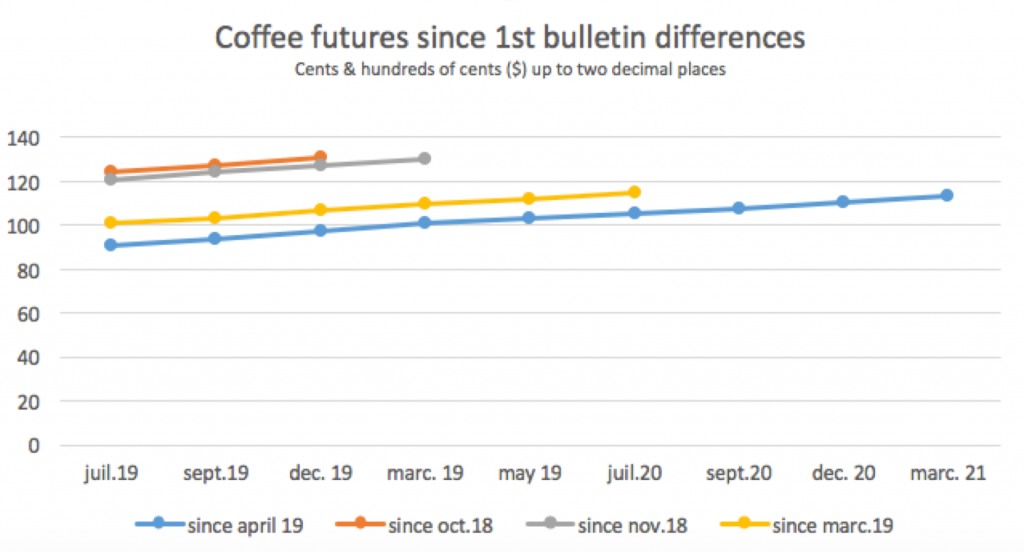
Cocoa’s spot and future price
Cocoa’s spot price / price in $ per MT
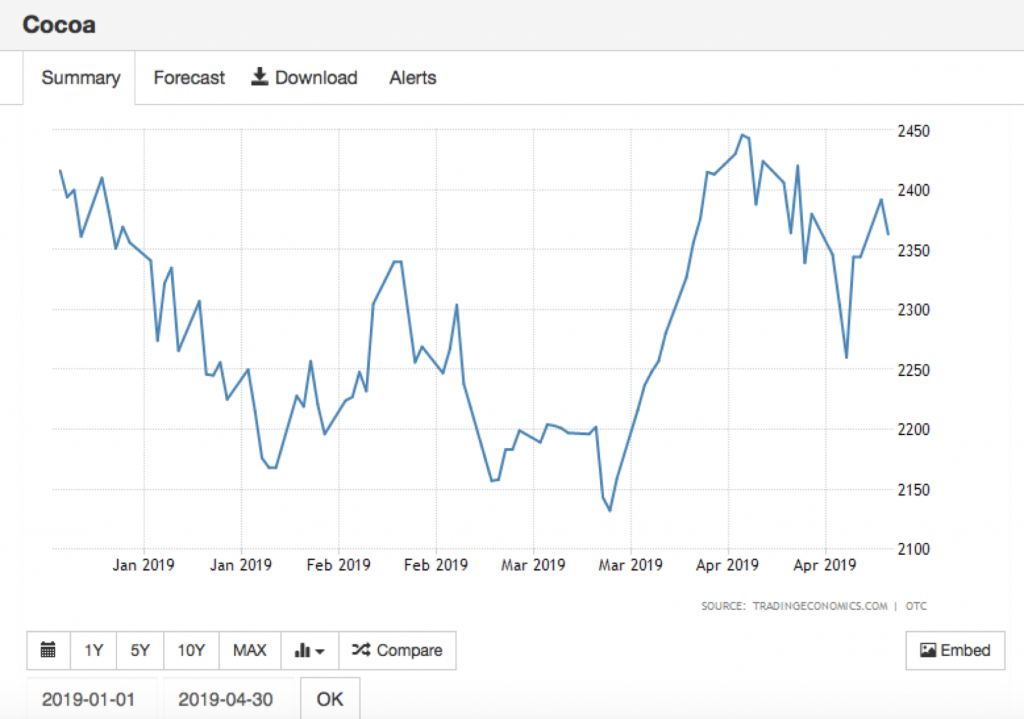
Cocoa’s future price
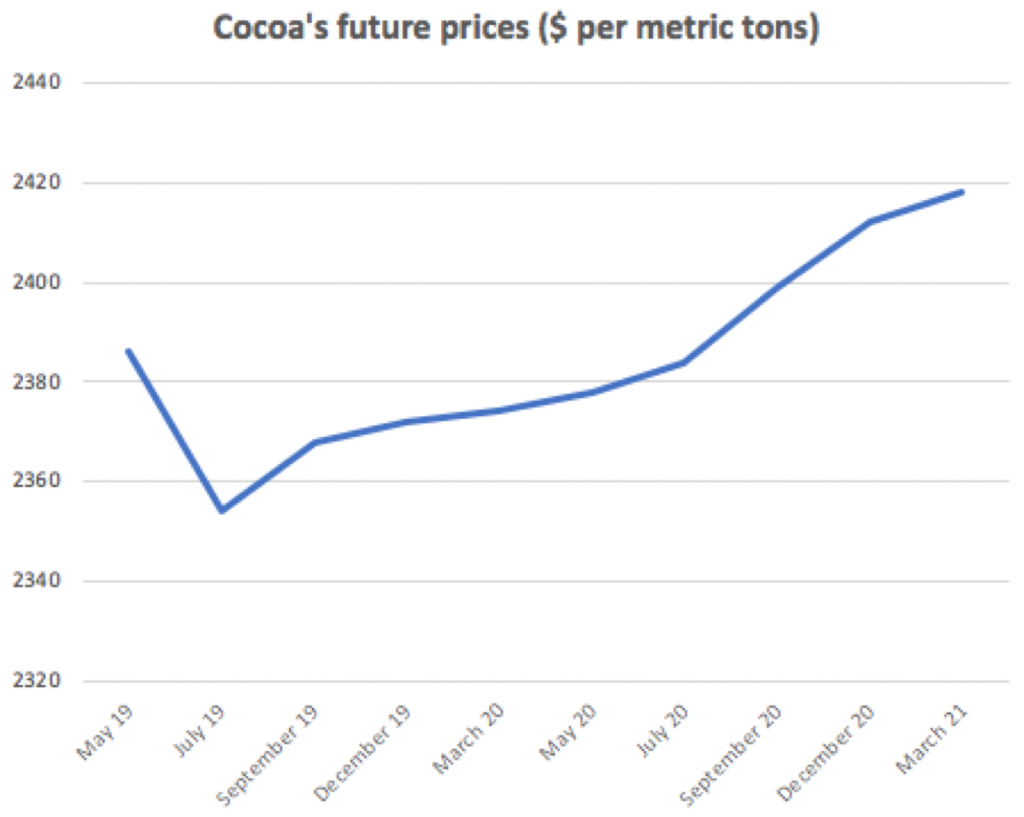
For the month of April 2019, the spot price of cocoa was equal to USD 2’368per MT, and is higher than the future price which is equal to USD 2’354per MT.
By referring to the cocoa’s future curve which shows the 10 metric tons’ future contract, the current cocoa market is in backwardation since the future curve is downward. Having the cocoa’s future price lower than the spot price, it means that currently the worldwide demand for cocoa is high, and the cocoa market is a bullish market. The reason of this high demand might be the end of the crop’s season of cocoa.
Small case study
First, we are a small company trading cocoa. Our aim is to develop the chocolate business in Asia, mainly in China. We are seeking either to buy or to grow more cocoa plantation and we are searching which country would be the best for us to buy or invest.
Actual China importation
At the beginning, we analysed the actual importation of cocoa from China in 2018, in order to understand what is the actual demand.

We saw the total import in 2018 equal to 4’125 thousand tons. Therefore, the China importation represents 0.8 percent, not even 1 percent of the total importation of cocoa. This data confirms us that there is a market to develop in this region.
From where to import?
In order to get a better understanding of the exporting countries and the actual trends, we did an analysis of the 4 biggest exporting countries comparing their productions between 2000 and 2018.
In 1999/2000
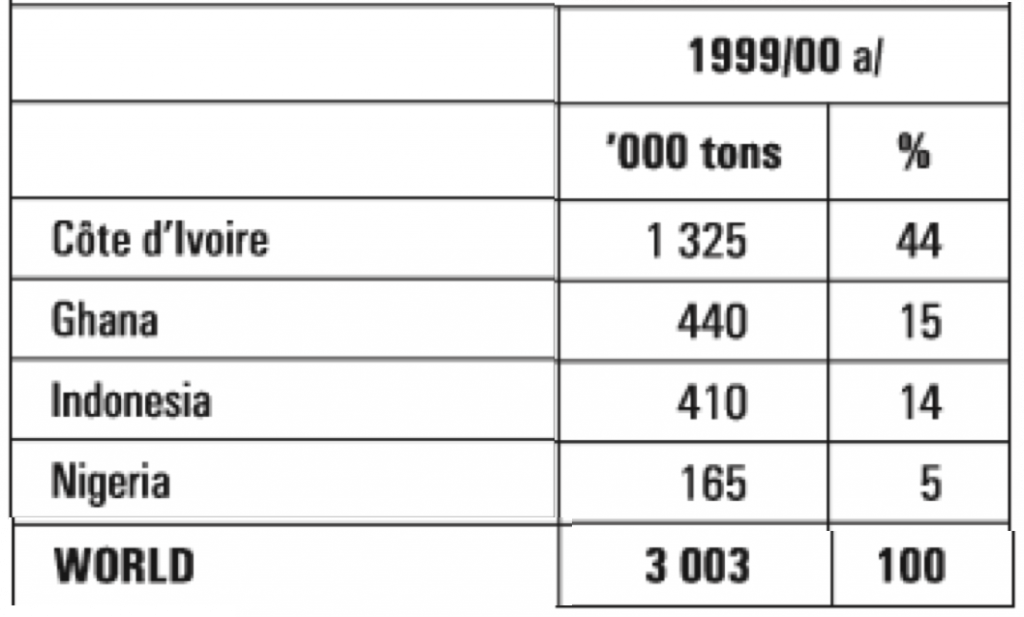
In 2018

What appeared at the first glance is the global production which increased from 2000 to 2018 from 3’003 thousand tons to 4’046 thousand tons.
We are facing an increase of more than 25 percent in 18 years. We can see that Côte d’Ivoire kept the first place and even increased its production.
Ghana doubled its production which show that they heavily invested in cocoa production and also that is a profitable business.
In contrary, Indonesia which is the closest country between the one above to China decrease from 410 thousand tons in 2000 to only 27 thousand tons in 2018. It appears that around 2012, following bad crops with small beans and many dead trees, Indonesia stopped their cocoa production for palm oil which request much less work as stated in the article from Reuters in 2012 “Indonesia’s “Frankentrees” turn cocoa dream into nightmare”.
Then by looking at the 10 biggest exporters in 2018, all of them are either from east Africa or Latin America except Malaysia which is the closest country from China with a constant increase in production since is 2014 reaching in 2018 a total of 155 thousand tons representing a little bit less than 4 percent of the global production.
Cocoa production in Malaysia

Malaysia seems not new in this business and had 9% market share in 1990 but surprisingly like Indonesia in 2012, their production crashed in less than 3 years as shown below.

The global exports of cocoa beans decreased from 9% in 1990 to 2% in 2000 This crash in production for 2 main raisons. The first one isby loss of production due to pests and diseases, and the second one was to benefit from the value added resulting from manufacturing its downstream products
Why there is a new growing trend in cocoa production?
Malaysia doesn’t only benefit from low production cost but also from a structure to process the beans. Indeed, based in the Peninsula can be found grindings and manufacturing plant for cocoa.
There is also another attributable of Malaysian cocoa which is the special characteristic of the high melting point of the Malaysian cocoa butter. This is advantageous for chocolate products in warm countries.
In conclusion, due to the following attributes stated above and to the proximity of Malaysia to China, I would definitely advice to invest in their cocoa plantation to supply the future demand from China.
Sources
REUTERS, 2019. “Dubai’s DMCC in talks with major coffee traders for new coffee centre”. Reuters(online) February 18th, 2019. Consulted on April 30th, 2019. Available at:
TRADING ECONOMICS, 2019. “Cocoa’s closing price”. April 30th, 2019. Available at: https://tradingeconomics.com/commodity/cocoa
THE ICE, 2019. “Cocoa’s future price”. Future contract July 2019. April 30th, 2019 Available at: https://www.theice.com/products/7/Cocoa-Futures/data?marketId=5546320
Cocoa, a guide to trade practices (developed partly by the WTO)Consulted on April 30th, 2019. Available at: http://www.intracen.org/uploadedFiles/intracenorg/Content/Publications/Cocoa%20-%20A%20Guide%20to%20Trade%20Practices%20English.pdf
ITC – International Trade Center. Consulted on April 30th, 2019. Available at: https://www.trademap.org/(S(n0bt52420brwnhk2djmqtk01))/Country_SelProductCountry_TS.aspx?nvpm=1%7c458%7c%7c%7c%7c1801%7c%7c%7c4%7c1%7c1%7c2%7c2%7c1%7c2%7c2%7c1
Reuters, Indonesia’s “Frankentrees” turn cocoa dream into nightmare https://www.reuters.com/article/us-cocoa-indonesia/indonesias-frankentrees-turn-cocoa-dream-into-nightmare-idUSBRE89E1DA20121015
Supply and Demand Model for the Malaysian Cocoa Market Consulted on April 30th, 2019. Available at: https://mpra.ub.uni-muenchen.de/…/11.Supply_and_Demand_Mo…
Traders wake up to cost of coffee crisis, Financial times, consulted on April 2019, available at: https://www.ft.com/content/21907ea6-5f98-11e9-a27a-fdd51850994c

